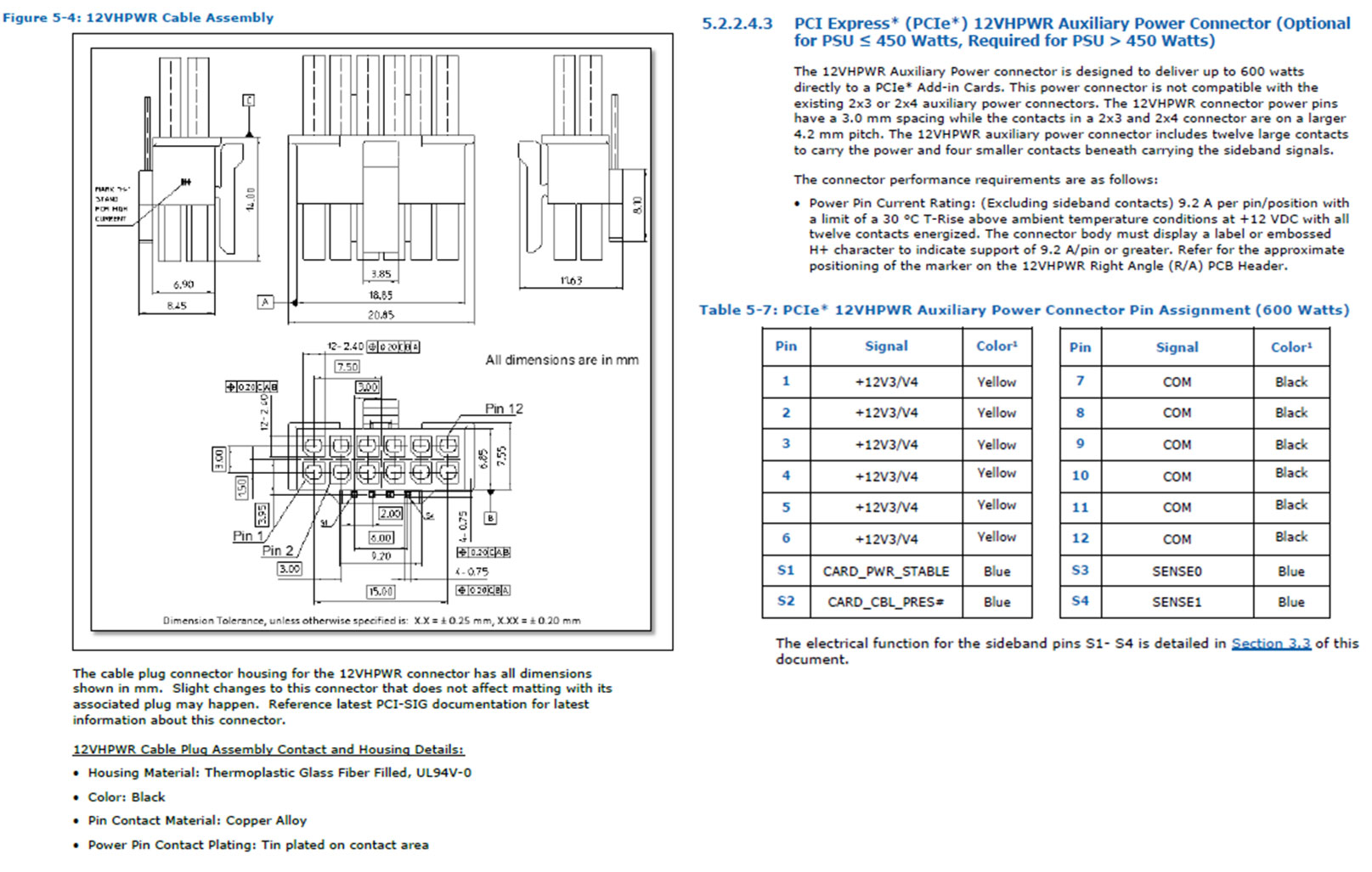Details of New 600W PCIe 5.0 Cable for GPUs Leaked
Some detailed specifications for the PCI Express 12VHPWR connector that can pump up to 600W of power to a GPU over a single cable have been posted as part of the ATX v3.0 design guide (via momomo_us). Pictures, illustrations, and descriptions provide a good overview of the modernized power delivery specification which will become important in powerful future PC builds, but be aware that this is leaked info as of yet, so take it with the requisite grain of salt.
In the images above, we get our first look at the suggested power rating labeling of the emerging power connector standard. Rather than use different sized connectors, which vary with the peak wattage they are expected to deliver, the standard will rely on the physically identical 16-pin (12 + 4) plug with max power delivery capability inscribed on the plug head. The accompanying image to the labeling example (above) simply shows the dimension tolerance of the design.
The diagrams confirm the size of the connector as being 20.85mm wide. For inside-your-PC size reference, the 4-pin Molex connector found in PCs measures 21mm wide (male). For a graphics card-relevant comparison, a single 8-pin PCIe connector measures about 19mm wide. The new 12VHPWR connector is quite deep, though, with its retention barb and sideband pins S1 – S4 which reside under the main 12 connectors.
We can also see the pin assignment table for a 600W connector. The power delivery comes through six 12V pins, so there are six corresponding ground lines. Previous leaks have pointed to the 12V pins delivering up to 9.2A each, and this documentation agrees on this spec, for a total theoretical max power delivery of 662.4W.
We don't have access to the official documentation section explaining the functions of the four sideband pins at this time. However, from the names, we guess they are for confirming the power connection to a graphics card and feeding back connection integrity/quality.
With custom overclocked graphics cards already pushing 420W, the new PCI Express 12VHPWR connector is a much more elegant way to supply this amount of power than an array of three 8-pin PCIe power connectors, for example.
Launched but Not Released PSUs Featuring 12VHPWR
On the topic of advanced PC power supplies and this upcoming PCIe standard, last week we spotted that the new Gigabyte UD1000GM had been launched with a 16-pin connector amongst its charms. A month earlier, the Asus ROG Loki broke cover, equipped with this same connector. Of course, neither Asus nor Gigabyte has released these PSUs to market, otherwise, we would have had a look at them and their new connectors.
Get Tom's Hardware's best news and in-depth reviews, straight to your inbox.

Mark Tyson is a news editor at Tom's Hardware. He enjoys covering the full breadth of PC tech; from business and semiconductor design to products approaching the edge of reason.
-
LuxZg I'm glad they actually made it one connector with different wattage.Reply
And hopefully the 4 auxiliary pins will have some kind of sensing or communication to announce to graphics card how much watts they support, so GPU can decide to run something like "emergency 2D only mode" that would just inform user that power delivery is inadequate, vs running full speed if PSU/cable can offer enough juice. I mean, with 4 pins you don't even need chip in PSU, it's enough to just have active/inactive pins, so eg 100W is pin 1 active, rest disabled, up to 600W with all 4 active. There's enough combinations to cover 50W increments
Main thing is we can actually have 450W PSU with this connector, and lower end GOU all running fine, not just use it for 1kW+ PSUs -
JeffreyP55 Reply
https://learnmetrics.com/wire-gauge-chart-amp-wire-sizes/Olle P said:Recommended wire gauge? -
InvalidError Reply
600W over 6 pairs is just over 8A per wire, so we're still talking #18.Olle P said:Recommended wire gauge?

